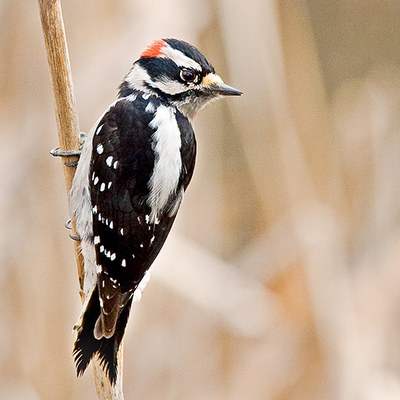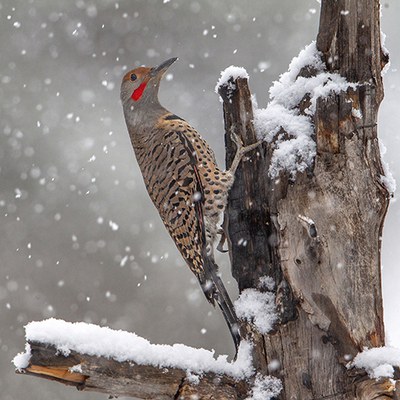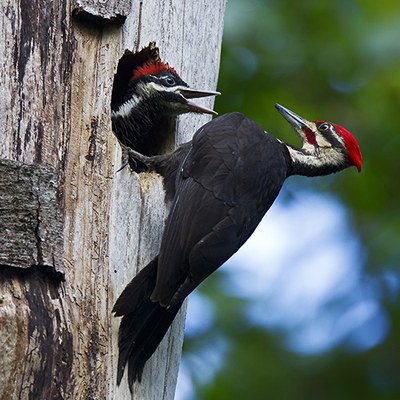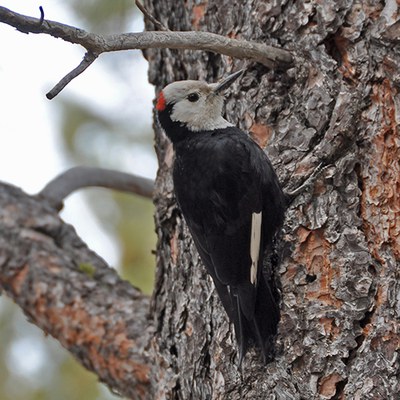Dut-dut-dut-dut-dut-dut-dut. The unmistakable sound of a woodpecker’s bill hitting a tree (or maybe a metal object). With the force of 1000g, it is an incredible feat that we hear it all the time in Central Oregon. But do you know your fellow forest dwellers? Here are a few of the native woodpeckers that call Central Oregon home.

Length: 6.75 inches
Wingspan: 12 inches
Downy woodpeckers are very similar-appearing to hairy woodpeckers (another woodpecker that can be found in Central Oregon), but are much smaller. They have a straight bill, blocky head, wide shoulders, and a straight back. Their head is white and black striped, and males have a red patch on the back of their head. They have a noticeable white stripe running down their back, while their wings are black checkered with white. In the winter, downy woodpeckers are often part of mixed species flocks of birds. The advantage of this is an easier time finding food and less time watching for predators. Males and females feed differently in the winter, too. The male downy woodpeckers search for food on smaller branches and weed stems (aka the better food spots) while females look for their food on larger branches and tree trunks. If males are not around, however, the females will go for those better food sources. Because they are a smaller woodpecker, they often eat food that larger woodpeckers cannot reach. Downy woodpeckers are also more acrobatic than larger woodpeckers. You can find them in open woodlands and on the brush-filled edges of forests. 
Length: 12.5 inches
Wingspan: 20 inches
This is an easy one to spot around town! Northern flickers have a slim head, slightly curved bill, white rump, and a long tail that tapers to a point. Their plumage is striking with a brown body patterned with black spots, bars, and crescents. The underside of their wing and tail feathers are a rosy red. Males have a bright red mustache stripe. Northern flickers mainly eat ants and beetles and because of this, are often spotted on the ground as they forage. They use their long, barbed tongue to lick up their meals. Northern flickers live in open habitats near trees.
Pileated woodpecker
Length: 16.5 inches
Wingspan: 29 inches
A more uncommon spotting, but what a woodpecker to see! Pileated woodpeckers are quite large with a distinctive flaming-red triangular crest. They are black with bold white stripes down their long neck. They have a long, chisel-like bill. When in flight, you can see pileated woodpeckers' largely white underwings. Their favorite food is carpenter ants and they will go to great lengths to get to them! They dig out rectangular holes in trees that are broad and deep, sometimes a foot or more long! Because of this, they live in forests that have lots of large, standing dead trees and downed wood. 
Length: 9.25 inches
Wingspan: 16 inches
An uncommon woodpecker that is only found in mountainous pine forests in the Western US and Canada. As you can probably tell from the name, they have a mostly white head. Males and juveniles have a red patch on the crown of their head. Their body is black and they have white outer flight feathers. White-headed woodpeckers have a short, sharp bill. This helps them eat large pine seeds, which they often place in tree crevices, then break apart to eat. They are largely associated with old-growth ponderosa pine and sugar pine forests. White-headed woodpeckers tend to flake away the bark of trees or dig into needle clusters to get at insects, instead of "drilling."
Now that you've learned about a few of Central Oregon's woodpeckers, here are a handful of additional facts about woodpeckers:
- Woodpeckers have stiff tail feathers that help them form a type of tripod against tree, allowing them to hold on to the sides of trees.
- In addition, woodpeckers have two toes that face backward and two toes that face forward. This also helps them move up and down the sides of trees.
- Woodpeckers have long tongues! They can be up to 1/3 of their total body length.
- Woodpeckers have fantastic hearing and listen for the sounds of insects crawling and chewing within trees.
- Woodpeckers have special feathers that cover their nostrils. This prevents dust and wood from getting into their nostrils when they're drilling in trees.
I hope the next time you're outdoors and you hear the familiar sound of a woodpecker, you're able to stop, watch the woodpecker (and maybe identify it!), and appreciate its place in the natural world.
Sources:
- All About Birds, The Cornell Lab of Ornithology
- The Sibley Field Guide to Birds of Western Northern America by David Allen Sibley
- 14 Mind-Blowing Woodpecker Facts You Should Know, Birds & Bloom
- 17 Fun and Gross Woodpecker Facts, Bird Advisors
Learn more:


